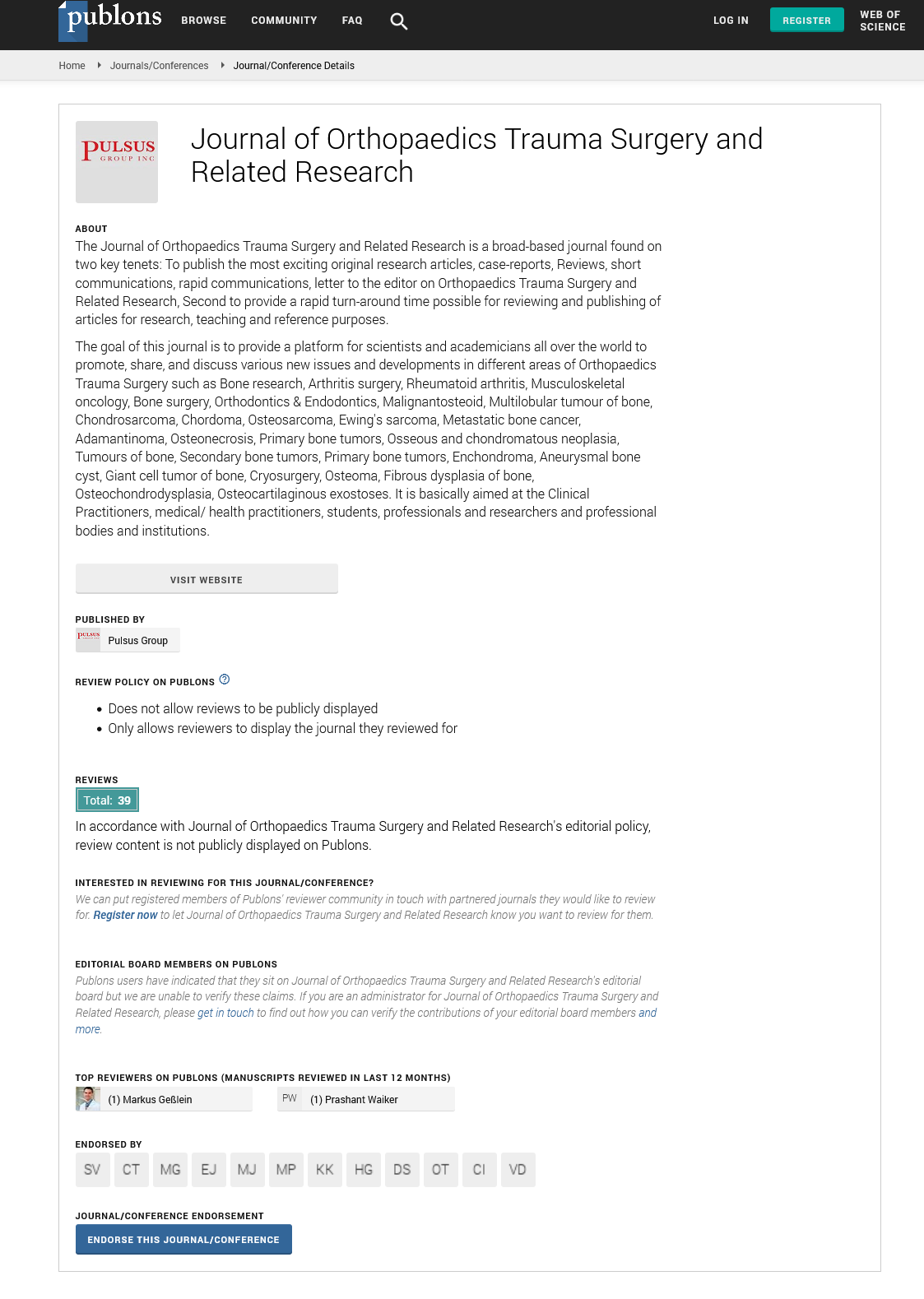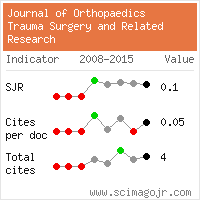Hemicorporectomy rehabilitation
Received: 11-Oct-2022, Manuscript No. jotsrr-22-78980 ; Editor assigned: 12-Oct-2022, Pre QC No. jotsrr-22-78980 (PQ); Accepted Date: Nov 07, 2022 ; Reviewed: 26-Oct-2022 QC No. jotsrr-22-78980 (Q); Revised: 03-Nov-2022, Manuscript No. jotsrr-22-78980 (R); Published: 09-Nov-2022, DOI: DOI. 10.37532/1897- 2276.2022.17(10).72
This open-access article is distributed under the terms of the Creative Commons Attribution Non-Commercial License (CC BY-NC) (http://creativecommons.org/licenses/by-nc/4.0/), which permits reuse, distribution and reproduction of the article, provided that the original work is properly cited and the reuse is restricted to noncommercial purposes. For commercial reuse, contact reprints@pulsus.com
Abstract
Hemicorporectomy is a surgical procedure that removes the lumbar spine and spinal cord, pelvic bones and contents, lower extremities, and external genitalia. The rehabilitation process is not only time-consuming and expensive, but also difficult. This article describes the rehabilitation process for hemicorporectomy and demonstrates innovative mobility solutions for paraplegic patients in two cases: case 1 due to traumatic spinal cord injury from a firearm injury and case 2 due to lumbosacral myelomeningocele. They had a chronic pressure ulcer that progressed to neoplastic transformation. (Marjolin’s ulcer - squamous cell carcinoma) The patients underwent L4 hemicorporectomy and were rehabilitated to ensure the right to mobility independence for activities of daily living; social inclusion; comorbidity prevention; and disability pluralization.
Keywords
Assistive Technology, Amputation, Hemicorporectomy, Rehabilitation, Prosthesis, Case Reports
Introduction
Hemicorporectomy, also known as translumbar amputation or translumbectomy, is a surgical procedure used to save someone who is in severe pain and at risk of death, in which the spine, lumbar spinal cord, pelvic bones and contents, lower extremities, and external genitalia are removed.
This permanent body modifying surgery is a sometimes curative treatment for trauma, ulcers, neoplasms, or locally extensive and advanced pelvic infectious processes that cannot be controlled by other treatments.
Pelvic traumatic crushing, osteomyelitis, squamous cell carcinoma, chondrosarcomas, and pressure ulcers complicated by Marjolin’s ulcer are all examples of refractory and intractable situations. Before amputation, the patient’s desire and acceptance, the stage of the disease that motivates the indication (tumour, infection, trauma, wound), the clinical and ethical conditions, the prognosis, and the patient’s ability to support and socialise must all be considered. In other words, not just the chances of survival but also the risk of death and willingness to live with functional resumption should be considered. To understand and deal with the physical, functional, and emotional manifestations of hemicorporectomy, the patient’s emotional and psychological conditions must be treated [1-4].
Case Presentation
The rehabilitation of two consecutive cases treated at the Instituto de Medicina Fisica e Reabilitaçao of the Hospital das Clinicas of the Faculdade de Medicina of the Universidade de Sao Paulo, SP, Brazil (IMREA-HCFMUSP) was carried out after receiving patients’ written informed consent and approval by the Ethics and Research Committee - Comisso de Ética para Análise de Projetos de Pesquisa – CAPPThe progression of the cases was evaluated before and after one year of rehabilitation, using standardised instruments validated for Brazilian Portuguese and routinely applied to IMREA-HCFMUSP patients, as shown below: The Functional Independence Measure (FIM):15 assesses a person’s performance in daily activities. Each item has seven levels of difficulty, with level seven representing total independence and level one representing total dependency [5-7].
World Health Organization Quality of Life Instrument-Brief Version (WHOQOL-bref): A World Health Organization (WHO) instrument that assesses overall quality of life.
Discussion
Hemicorporectomy is a surgical procedure that removes a large body mass with perioperative morbidity. Ferrara et al. described the best postoperative outcome for pressure ulcer hemicorporectomy. Patients with congenital paraplegia have a more facilitated rehabilitation process, according to Elliot P et al., because even the paralysed parts are functional, and they learn to take advantage of the full potential for functionality. These facts could have influenced our findings. Despite the lack of data in the literature on the subject, we can compare and rely on patients with proximal amputations, such as hip disarticulation and hemipelvectomywhich are more similar to hemicorporectomy. The morbidity of these amputations is higher. The greater the energy expenditure for prosthetic gait, the closer the amputation level. Furthermore, it is difficult to stabilise, balance, and balance with the prosthesis during gait, which makes the use of prostheses a less functional process in more proximal amputations.
However, as prosthetic technology advances, patients are increasingly choosing prosthetics for primary locomotion.
35 Patients in our study continued to use their prostheses for outdoor activities, short-distance walking indoors and outdoors, and social presentations.
Rehabilitation after hemicorporectomy is lengthy and difficult, but according to other studies5, many patients have been able to reintegrate into the labour force, returning to preoperative occupations and enjoying a higher quality of life. The patient in the first case, who was previously unemployed and reliant on government benefits, became an employer, had a more social life, married, and improved his and his family’s economic circumstances. In the second case, the patient went from being unemployed to having two jobs, which improved his working conditions and social life [8,9].
In our institution’s daily clinical practise, people with paraplegia consider removing their lower limbs and imagining how they would function without the legs. This type of behaviour, obviously, cannot be proposed or practised. However, these two cases show that in extreme situations, where there is a risk of death and previous attempts have failed, being without lower limbs through a specific body modifying procedure can be the solution that not only provides a question of survival, but also real gains in functionality, social participation, and productive life. We only report two cases of hemicorporectomy because it is a rare procedure. Although there has been no variation in surgical technique thus far, postoperative management, environmental conditions, and social support for each case have been different, making it difficult to form a homogeneous group. We only review patients’ medical records, limiting the amount of data that can be gathered.
Conclusion
Hemicorporectomy may be a therapeutic option for those in need because it restores functionality without the need for caregivers and reestablishes educational, professional, economic, and social aspects while improving quality of life.
References
- La Du BN, Zannoni VG, Laster L et al. The nature of the defect in tyrosine metabolism in alkaptonuria. J Biol Chem 1958; 230: 251-60. [Google Scholar] [CrossRef]
- O'Brien WM, La Du BN, Bunim JJ. Biochemical, pathologic and clinical aspects of alkaptonuria, ochronosis and ochronotic arthropathy: review of world literature (1584-1962). Am J Med 1963;34:813-38. [GoogleScholar][CrossRef]
- Phornphutkul C, Introne WJ, Perry MB, et al. Natural history of alkaptonuria. N Engl J Med 2002; 347: 2111-21. [Google Scholar][CrossRef]
- Zannoni VG, Lomtevas N, Goldfinger S. Oxidation of homogentisic acid to ochronotic pigment in connective tissue. Biochim Biophys Acta 1969;177: 94-105 [Google Scholar][CrossRef]
- Lorenzini S, Mannoni A, Selvi E et al. Alkaptonuria. N Engl J Med. 2003; 348(14):1408. [Google Scholar][CrossRef]
- Aydogdu S, Cullu E, Ozsoy MG, et al. Cementless total knee arthroplasty in ochronotic arthropathy: a case report with four-year follow-up. J Arthroplasty 2000;15:539-43. [Google Scholar][CrossRef]
- Carrier DA, Harris CM. Bilateral hip and bilateral knee arthroplasties in a patient with ochronotic arthropathy. Orthop Rev 1990;19:1005-9. [Google Scholar][CrossRef]
- Dom K, Pittevils T. Ochronotic arthropathy, the black hip: case report and review of the literature. Acta Orthop Belg 1997;63:122-5. [Google Scholar][CrossRef]
- Emel E, Karagoz F, Aydin IH, et al. Alkaptonuria with lumbar disc herniation: a report of two cases. Spine 2000;25:2141-4. [Google Scholar][CrossRef]



 Journal of Orthopaedics Trauma Surgery and Related Research a publication of Polish Society, is a peer-reviewed online journal with quaterly print on demand compilation of issues published.
Journal of Orthopaedics Trauma Surgery and Related Research a publication of Polish Society, is a peer-reviewed online journal with quaterly print on demand compilation of issues published.